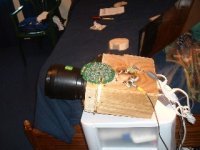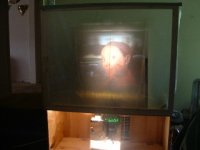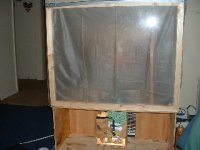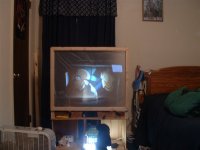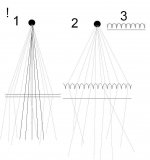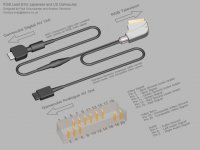Well I got my LCDs today. They came Tuesday but I was not here to get them. I didnt know they came Tuesday, I was still waiting on them. So today I called Fedex and they told me my they had been delivered. Come to find out my dorm director signed for them and they were in his office for two days.
All of the lcds are in great condition but one it as a broken hinge. They all look like they work. I have no way of testing them because I do not have a power supply.
All of the lcds are in great condition but one it as a broken hinge. They all look like they work. I have no way of testing them because I do not have a power supply.
Well I'm home and I tested all the lcds. All of them works, the backlit on two them do not work. A great deal 33.49.
I build the projector that goes inside case, but I don't think its bright enough. I can barely watch it on the wall. Looks like I might have to find a new light source. If anyone has any ideas post them.
In the picture its basically the design as my first one. I used the Figinon lens form surplus shed, Sony Psone LCD, a fan and a light source. The light source is a 150 watt halogen bulb, which is not bright enough. I might try one of those MH bulbs other people are using and see what happens.
I build the projector that goes inside case, but I don't think its bright enough. I can barely watch it on the wall. Looks like I might have to find a new light source. If anyone has any ideas post them.
In the picture its basically the design as my first one. I used the Figinon lens form surplus shed, Sony Psone LCD, a fan and a light source. The light source is a 150 watt halogen bulb, which is not bright enough. I might try one of those MH bulbs other people are using and see what happens.
Attachments
Here is the start of my new rear projection tv. Its basically the same as the first one, but I figured out how to make the screen more viewable. The first one I build the screen was lower which caused me to look down on the screen to see it. The new screen will be 6 to 12 inches higher which should make it eye level. I also solved the brightness problem by making something that keeps alot of the light in. All it is three pieces of wood, two of them has a circle cut out the center the diameter of my Figinon lense. The other has a rectangle cut out of it to hold the screen. Now no light is leaked out when it is turned.
The picture I post does not have the right sized mirror thats why the projected picture is so small. A mirror the size of screen is better because increased brightness and makes the tv thinner in it's depth. A glass mirror the size of my screen will be heavy and expensive thats why I'm going for a acrylic mirror from www.usplastics.com 48X24 only $26.00.
Later this week I will post some pictures to show my progress.
The picture I post does not have the right sized mirror thats why the projected picture is so small. A mirror the size of screen is better because increased brightness and makes the tv thinner in it's depth. A glass mirror the size of my screen will be heavy and expensive thats why I'm going for a acrylic mirror from www.usplastics.com 48X24 only $26.00.
Later this week I will post some pictures to show my progress.
Attachments
rmccoll said:......
I build the projector that goes inside case, but I don't think its bright enough. I can barely watch it on the wall. Looks like I might have to find a new light source. If anyone has any ideas post them.
In the picture its basically the design as my first one. I used the Figinon lens form surplus shed, Sony Psone LCD, a fan and a light source. The light source is a 150 watt halogen bulb, which is not bright enough. I might try one of those MH bulbs other people are using and see what happens.
heya rmccoll,
nice job.
there's a mod for that psone-lcd makes the picter brighter. see here .. http://diyaudio.com/forums/showthread.php?postid=400154#post400154
i'm usin a 70 W hqi from osram in my pj. that's bright enough to see already in the dawn. for a rear-pro it'll be enough.
hope that helps abit.
Here are_my latest result from my project. I figured out that I don’t need to use a mirror the size of my screen to get a brighter picture. The mirror I’m using now is only 20X16, the gold trim around the mirror is causing a reflection on the screen. As you can see in the picture my projected image is smaller, but only by 4 inches. Once I get the whole thing build and paint the inside black the image will be much brighter.
Attachments
Hot-Spotting and the right screen to use
Hot spotting should not be a problem, if it is here are two of the reasons:
1) Too much direct light is getting through the screen,e.g. the screen is not diffracting the light. Sorry a shower curtain will never work! As it is not diffracting enough light. Hot spotting is ocouring because too many of the rays of light are able to pass straight through the screen in comparison to the number that are being diffracted. Hopefully the following diagram will help you
***Hopefully the diagram I am now going to refer to will upload ok with this post!***
In diagram 1 the black lines are the light that passes straight through the screen, the grey lines are the lines that are are being diffracted by the pitts in the glass. By the way the only way to go is a screen made out of glass!! Basically what is hanening is you are seeing too many rays of light coming straight from the blub e.g. the black lines!!!
In diagram 2 the screen is far more pitted on the back so all of the light is diffracted. Imagine millions more light lines of course, the result is a dimmer screen but with no noticeable hot spotting. Very little light just goes straight through the screen, un-diffracted, now that is the secret to success.
By the way, anyone wondering why the glass is thicker on picture 2, it’s not intended to be, when I was drawing it in Paint I forgot to move the straight line, and started to put in the light lines, then I realized and couldn’t be bothered to start agin!
To anyone wondering if this works, back in the 1980’s I did presentations using 16mm film projectors with screens sometimes greater than 6 feet in diameter, with no hot spotting problems. Some “serious film amateurs” (very serious in my mind!!!) had small cimemas in their houses and used rear projection because you can hide some of the sound of the projectors, and again no hot spot problems. The surface of the glass is not smooth, it is very very very pitted, so the light is diffracted in all directions.
2) Reason two, is down to incorrect optics, e.g. focal length of light condenser lenses, sorry I cant give any more info here but it is really a case by case scenario.
As for making a screen, they are called ground glass, but having talked to some of my ex-colleagues recently, it would appear that the name is a little deceptive; a better description is ‘severely sand blasted glass’, where the glass is really white and ruff on the projection surface (any one who has done any sand blasting of glass will recognise what I mean by that), not just a little white, but really white. Easy to make if you have a compressor and sand blasting gun. The firm I used to work for made our own screens in our workshop, so it can be done, we didn’t have any special tools ect. Now a very interesting idea I have been told about is that once the screen was sand blasted severely, it was often given a coat of black paint, then using sand paper or steel wool it was scraped back to reveal the top “humps” as it were of glass, leaving a slight back coating, it would improve viewing a wide angles as only diffracted light went through and bright ambient room light was reflected. Diagram 3 shows this idea. It would be interesting for someone to try this again! This was done before the days of easily available anti-reflective coatings. This is also basically the same idea as glass impregnated black plastic screens!
Just one more thing, please stop using / recommending shower curtains, I hope from what I have written above you will all see why they will never work, though I guess they are good just to test your ideas!
I’m working on my own design at the moment, to see if it will work with some old kit that I have accumulated over the years, I will post some results when I get started properly.
Hot spotting should not be a problem, if it is here are two of the reasons:
1) Too much direct light is getting through the screen,e.g. the screen is not diffracting the light. Sorry a shower curtain will never work! As it is not diffracting enough light. Hot spotting is ocouring because too many of the rays of light are able to pass straight through the screen in comparison to the number that are being diffracted. Hopefully the following diagram will help you
***Hopefully the diagram I am now going to refer to will upload ok with this post!***
In diagram 1 the black lines are the light that passes straight through the screen, the grey lines are the lines that are are being diffracted by the pitts in the glass. By the way the only way to go is a screen made out of glass!! Basically what is hanening is you are seeing too many rays of light coming straight from the blub e.g. the black lines!!!
In diagram 2 the screen is far more pitted on the back so all of the light is diffracted. Imagine millions more light lines of course, the result is a dimmer screen but with no noticeable hot spotting. Very little light just goes straight through the screen, un-diffracted, now that is the secret to success.
By the way, anyone wondering why the glass is thicker on picture 2, it’s not intended to be, when I was drawing it in Paint I forgot to move the straight line, and started to put in the light lines, then I realized and couldn’t be bothered to start agin!
To anyone wondering if this works, back in the 1980’s I did presentations using 16mm film projectors with screens sometimes greater than 6 feet in diameter, with no hot spotting problems. Some “serious film amateurs” (very serious in my mind!!!) had small cimemas in their houses and used rear projection because you can hide some of the sound of the projectors, and again no hot spot problems. The surface of the glass is not smooth, it is very very very pitted, so the light is diffracted in all directions.
2) Reason two, is down to incorrect optics, e.g. focal length of light condenser lenses, sorry I cant give any more info here but it is really a case by case scenario.
As for making a screen, they are called ground glass, but having talked to some of my ex-colleagues recently, it would appear that the name is a little deceptive; a better description is ‘severely sand blasted glass’, where the glass is really white and ruff on the projection surface (any one who has done any sand blasting of glass will recognise what I mean by that), not just a little white, but really white. Easy to make if you have a compressor and sand blasting gun. The firm I used to work for made our own screens in our workshop, so it can be done, we didn’t have any special tools ect. Now a very interesting idea I have been told about is that once the screen was sand blasted severely, it was often given a coat of black paint, then using sand paper or steel wool it was scraped back to reveal the top “humps” as it were of glass, leaving a slight back coating, it would improve viewing a wide angles as only diffracted light went through and bright ambient room light was reflected. Diagram 3 shows this idea. It would be interesting for someone to try this again! This was done before the days of easily available anti-reflective coatings. This is also basically the same idea as glass impregnated black plastic screens!
Just one more thing, please stop using / recommending shower curtains, I hope from what I have written above you will all see why they will never work, though I guess they are good just to test your ideas!
I’m working on my own design at the moment, to see if it will work with some old kit that I have accumulated over the years, I will post some results when I get started properly.
Attachments
I already knew about defraction and how it make your viewing area better. I can tell from your diagram that you paid a visit to www.uspto.gov because I know how they diagrams look like. It is a great place to visit when you need diagram of something.
I can see what you are saying, but everyone does not have the resources or the money to buy sand blasted glass. Sure it will make a better screen than a shower curtain but right now I using that. Another choice is a large fresnel from www.elec-goldmine.com it a little expensive $70.00 but it will work great.
I can see what you are saying, but everyone does not have the resources or the money to buy sand blasted glass. Sure it will make a better screen than a shower curtain but right now I using that. Another choice is a large fresnel from www.elec-goldmine.com it a little expensive $70.00 but it will work great.
I can tell from your diagram that you paid a visit to www.uspto.gov
Just to be fussy, actually I have never even seen that site, I just drew them on Paint myself. As for cost, I'll give you that one, it would be expensive to buy, but there is always a chance that people know friends who have sand blasting equiptment, it's not all that expensive and people who are into cars would prob have an air compressor, or you could hire it really cheap for the day.
But jibes aside, i'm very interested to know about resolution issues, you say you are using a 'Sony Psone LCD', must confess I had to ask my son if he knew what it was, it looks like it is low resolution compared with tv, e.g. tv here in the uk we have 625 lines, or 720x576 pxs (not that you can even get that through a SCART cable anyway as it doens't have the bandwidth I would say it's more like 400x576 pxs), how does your panel compare to that, as in reality of course you are only getting 288 lines every 1/50 of a second as both fields of the interlaced frame are never shown at the same time. And even with say a progressive dvd player the output frame, although progressive on a dvd which is encoded using progressive frames, will prob still be split into odd and even scan lines as SCART cabels just don't have the bandwidth. So my question is really, what resolution do you actually get from small panels, what is your panel and how big is your screen, do you see and pixls ect?
Second, say you have a panel that is 288 x 352 pxs. Are these panels clever enough to display the 288 odd lines then 288 even scan lines one after another or not?
I already have a Panasonic RPTV that I bought several years back for our living room, and am thinking about building one from my bedroom, you never know, I might get lucky, the wife may like the idea, but i'm not holding my breath. So a small pannel would be easy to get, as oposed to ripping apart a computer LCD screen.
Ages ago I posted an idea I had for using an OHP, but looking around on the Internet I see that there is just not the range of OHPs on the market today, many of what I would have considdered the better makes to buy seem to not even exist anymore, the same applies for projection lens. Since leaving the A/V industry in the mid 80's i'm amazed how far it's progressed in such a short time. The same aplies for prices of items, e.g. mirrors and as you say glass!!
My screen is 960X234 and it shows really good up to 70'' on the wall. I'm using this screen because I trying to build it on a budget $200 or less and it keeps my overall design small. Try building a rear projection tv using a computer LCD monitor and OHP projector. Sure it will bright and the resolution will be good, but it will huge as a whole. My entire tv is 36''X30''X40'' its small, light and easy to move.
It seems you know alot about television can you help me with this idea I have. Ok you know RGB signals that some televisions use. What if I take Red, Green and Blue LEDs the bright kind and feed a RGB signal into them. It will result in them flashing from the incoming signal. Then I use a lens to focus the light into a single dot and use two mirrors one horizontal and on vertical to create a picture. I'm sure it will work, what about you?
It seems you know alot about television can you help me with this idea I have. Ok you know RGB signals that some televisions use. What if I take Red, Green and Blue LEDs the bright kind and feed a RGB signal into them. It will result in them flashing from the incoming signal. Then I use a lens to focus the light into a single dot and use two mirrors one horizontal and on vertical to create a picture. I'm sure it will work, what about you?
RGB ect
I’m surprised, so in fact quite a low resolution screen, I’m guessing the 960 is not it’s native horizontal but it’s total RGB horizontal resolution. 70” is certainly very impressive for $200, you have my respect!
I did wonder about resolutions of lcd panels, as back when I was in the business it was CRT all the way, LCD was brand spanking new technology out of reach of all but the largest companies, (to be honest I have yet to see a LCD projector or LCD RPTV that makes me think LCD is better, they certainly don’t have the contrast that CRT has, but I don’t think this is the place for a LCD vs CRT argument as from what I have read on these pages both have their die hard fans!) and with CRTs, horizontal resolution was not really an issue being analogue. I think you are right about small panels as a small footprint for the tv is certainly beneficial for most people’s homes these days.
Well, don’t credit me with too much, I don’t think I really deserve it, I left the A/V industry, (back then some of us still called it the A/F industry (audio/film)) in the mid 1980’s, it was then that all the new technology came along, e.g. digital picture processing, LCDs and flat screen crt tvs started to take off after spending years in the shadows. I never really ventured into the inner workings of tvs, film was my department, but we all help each other out so over time learnt about the theories behind tvs ect, the closest I ever came was helping set up CRT projectors/RPTVs (not for the faint hearted I would add!) and building some elementary video processing circuits, e.g. RGB to Video and vice versa ect.
As for you idea, do you mean use 3 leds to project an image using mirrors, just like an Optical printer in fact, but use leds instead of Lasers?
If this is the case, there would be several issues to overcome, 1st would be an issue of a screen, you would need one like a tv, e.g. it would need to hold a latent image for a while, as obviously the leds cant scan every pxl all the time. Second would be the ability to acrutly plot out the lines on the screen, very difficult I suspect.
If I have misunderstood you, and in fact you mean to have 3 leds for every pxl and have rows of these, both vertical and horizontally, then project this whole image which is made up using all the leds, well in theory it would be possible, as this is how in part some very big ‘video walls’ work, using leds. But I would not have a clue how to build a processing circuit to assign each bit of colour information to each group of 3 leds. It would have to be a very heavy duty circuit as video has a very high band width, I would say the biggest problem would be to create a good usable time base, as when a video signal is sent along a wire, due to bandwidth issues the individual pixels as it were can get merged or become mixed or combined, this is not really an issue with a CRT but could be for a video wall, hope that is clear. This is a big issue with NTSC, the bandwidth is just not available to have it’s maximum theoretical resolution and full colour too, hence why (no offence to anyone who’s country’s standard is NTSC!!) it looks pretty shoddy, as it’s based on a black and white picture with very minimal additional colour information)
So if the 2nd idea is in fact what you mean, it is possible but I would say it is very hard to do, and the electronics necessary would be very expensive to build/design. I mean that is after all basically what LCD panels are doing.
If I have completely misunderstood you, do say and I’ll have another crack at trying to answer your question for you.
My screen is 960X234 and it shows really good up to 70'' on the wall
I’m surprised, so in fact quite a low resolution screen, I’m guessing the 960 is not it’s native horizontal but it’s total RGB horizontal resolution. 70” is certainly very impressive for $200, you have my respect!
I did wonder about resolutions of lcd panels, as back when I was in the business it was CRT all the way, LCD was brand spanking new technology out of reach of all but the largest companies, (to be honest I have yet to see a LCD projector or LCD RPTV that makes me think LCD is better, they certainly don’t have the contrast that CRT has, but I don’t think this is the place for a LCD vs CRT argument as from what I have read on these pages both have their die hard fans!) and with CRTs, horizontal resolution was not really an issue being analogue. I think you are right about small panels as a small footprint for the tv is certainly beneficial for most people’s homes these days.
It seems you know alot about television
Well, don’t credit me with too much, I don’t think I really deserve it, I left the A/V industry, (back then some of us still called it the A/F industry (audio/film)) in the mid 1980’s, it was then that all the new technology came along, e.g. digital picture processing, LCDs and flat screen crt tvs started to take off after spending years in the shadows. I never really ventured into the inner workings of tvs, film was my department, but we all help each other out so over time learnt about the theories behind tvs ect, the closest I ever came was helping set up CRT projectors/RPTVs (not for the faint hearted I would add!) and building some elementary video processing circuits, e.g. RGB to Video and vice versa ect.
As for you idea, do you mean use 3 leds to project an image using mirrors, just like an Optical printer in fact, but use leds instead of Lasers?
If this is the case, there would be several issues to overcome, 1st would be an issue of a screen, you would need one like a tv, e.g. it would need to hold a latent image for a while, as obviously the leds cant scan every pxl all the time. Second would be the ability to acrutly plot out the lines on the screen, very difficult I suspect.
If I have misunderstood you, and in fact you mean to have 3 leds for every pxl and have rows of these, both vertical and horizontally, then project this whole image which is made up using all the leds, well in theory it would be possible, as this is how in part some very big ‘video walls’ work, using leds. But I would not have a clue how to build a processing circuit to assign each bit of colour information to each group of 3 leds. It would have to be a very heavy duty circuit as video has a very high band width, I would say the biggest problem would be to create a good usable time base, as when a video signal is sent along a wire, due to bandwidth issues the individual pixels as it were can get merged or become mixed or combined, this is not really an issue with a CRT but could be for a video wall, hope that is clear. This is a big issue with NTSC, the bandwidth is just not available to have it’s maximum theoretical resolution and full colour too, hence why (no offence to anyone who’s country’s standard is NTSC!!) it looks pretty shoddy, as it’s based on a black and white picture with very minimal additional colour information)
So if the 2nd idea is in fact what you mean, it is possible but I would say it is very hard to do, and the electronics necessary would be very expensive to build/design. I mean that is after all basically what LCD panels are doing.
If I have completely misunderstood you, do say and I’ll have another crack at trying to answer your question for you.
No its one group of RGB leds that forms one pixel on the screen. Its like a regular tv tube, were electron gun in the back scan the picture on screen. Like a big electron gun using LEDs. Using this modified cable I think I may be able to get the LEDs work, but I'm no electronics expert.
Attachments
Hey, I read somewhere that you could sand blast plexiglass to get a similar effect to sandblasted glass. Having read the earlier post suggesting "ground glass" and then visiting a couple of links describing how to do it yourself, I wonder if a similar effect could be done on plexi in a similar way. I was thinking that automotive rubbing compound and a piece of regular glass as the surface you rub with might work. I assume that the reason that the instructions for glass required using a second piece of glass was so the abrasion would be more uniform.
Any Ideas?
Any Ideas?
Re: RGB ect
" I’m guessing the 960 is not it’s native horizontal but it’s total RGB horizontal resolution. "
A lot of lcd monitors are being advertised on ebay as being "High Resolution" and giving numbers like that. They're giving numbers like 224,460---116,160- and using pixels and dots interchangably. I try to tell myself that it's just a translation error or someone is misinformed but find it very hard to do so. You likely already did this but if you assume that they mean dots multiplied by rows then the above is almost 4:3 resolution.
Very confusing and irritating.
" I’m guessing the 960 is not it’s native horizontal but it’s total RGB horizontal resolution. "
A lot of lcd monitors are being advertised on ebay as being "High Resolution" and giving numbers like that. They're giving numbers like 224,460---116,160- and using pixels and dots interchangably. I try to tell myself that it's just a translation error or someone is misinformed but find it very hard to do so. You likely already did this but if you assume that they mean dots multiplied by rows then the above is almost 4:3 resolution.
Very confusing and irritating.
New Idea.... Need advice
Okay, this one is odd.
I want to use a OHP + LCD to project against two mirrors, and rear project on plexiglass. I'm looking to mount a 7' wide x 5.25' high plexiglass window in side of a step van. I figured I would use real rear projection material stretched on a frame up against the back of the plexiglass. I plan to mount the projector + mirror on a frame that is sitting on air suspension. My focal distance might be an issue, the cargo area of the truck I want to use is 10' long total.
My big worry is the plexiglass. I'm afraid the outside will reflect too much light (it will be shiny). Any thoughts? Should I bead blast the outside of the plexi? Will the image focus nicely?
I plan to use a 400 watt MH lamp on an overhead. Think it will be bright?
Okay, this one is odd.
I want to use a OHP + LCD to project against two mirrors, and rear project on plexiglass. I'm looking to mount a 7' wide x 5.25' high plexiglass window in side of a step van. I figured I would use real rear projection material stretched on a frame up against the back of the plexiglass. I plan to mount the projector + mirror on a frame that is sitting on air suspension. My focal distance might be an issue, the cargo area of the truck I want to use is 10' long total.
My big worry is the plexiglass. I'm afraid the outside will reflect too much light (it will be shiny). Any thoughts? Should I bead blast the outside of the plexi? Will the image focus nicely?
I plan to use a 400 watt MH lamp on an overhead. Think it will be bright?
Project against two mirrors is to reach the size you're looking for, right?
The air suspension is because the vehicle will be moving and you want to have a steady picture, is that correct? If so have you made sure you will not find yourself in trouble with the fuzz? They can get real snotty.
I think you could use some kind of sheer fabric over the plexi (on the outside) if it doesn't restrict the field of view too much.
The air suspension is because the vehicle will be moving and you want to have a steady picture, is that correct? If so have you made sure you will not find yourself in trouble with the fuzz? They can get real snotty.
I think you could use some kind of sheer fabric over the plexi (on the outside) if it doesn't restrict the field of view too much.
Yea, I'm not sure what the laws will have to say about it. My goal when moving is to show a static logo for a website and have the background move at the exact same speed the vehicle is moving.
I was thinking, perhaps if the out side of the plexiglass was glass bead blasted or something, that would eliminate the glossy factor and allow the projection to hit that part. No idea if that would really work, and with the projector side being glossy how much light scatter would be created.
I was thinking, perhaps if the out side of the plexiglass was glass bead blasted or something, that would eliminate the glossy factor and allow the projection to hit that part. No idea if that would really work, and with the projector side being glossy how much light scatter would be created.
Hi, I read your post and I think I can help you. Instead of plexi-glass alone put thin sheets of HPDE over it. HPDE looks like sanded thin sheets of plexi-glass, it will form around your van very easily. You can find some good sized sheets on ebay.
As for mounting the project, try attaching it to your screen with some pieces of wood so it can move with your screen.
As for mounting the project, try attaching it to your screen with some pieces of wood so it can move with your screen.
- Status
- This old topic is closed. If you want to reopen this topic, contact a moderator using the "Report Post" button.
- Home
- General Interest
- Everything Else
- The Moving Image
- DIY Projectors
- DIY Rear Projection TV
